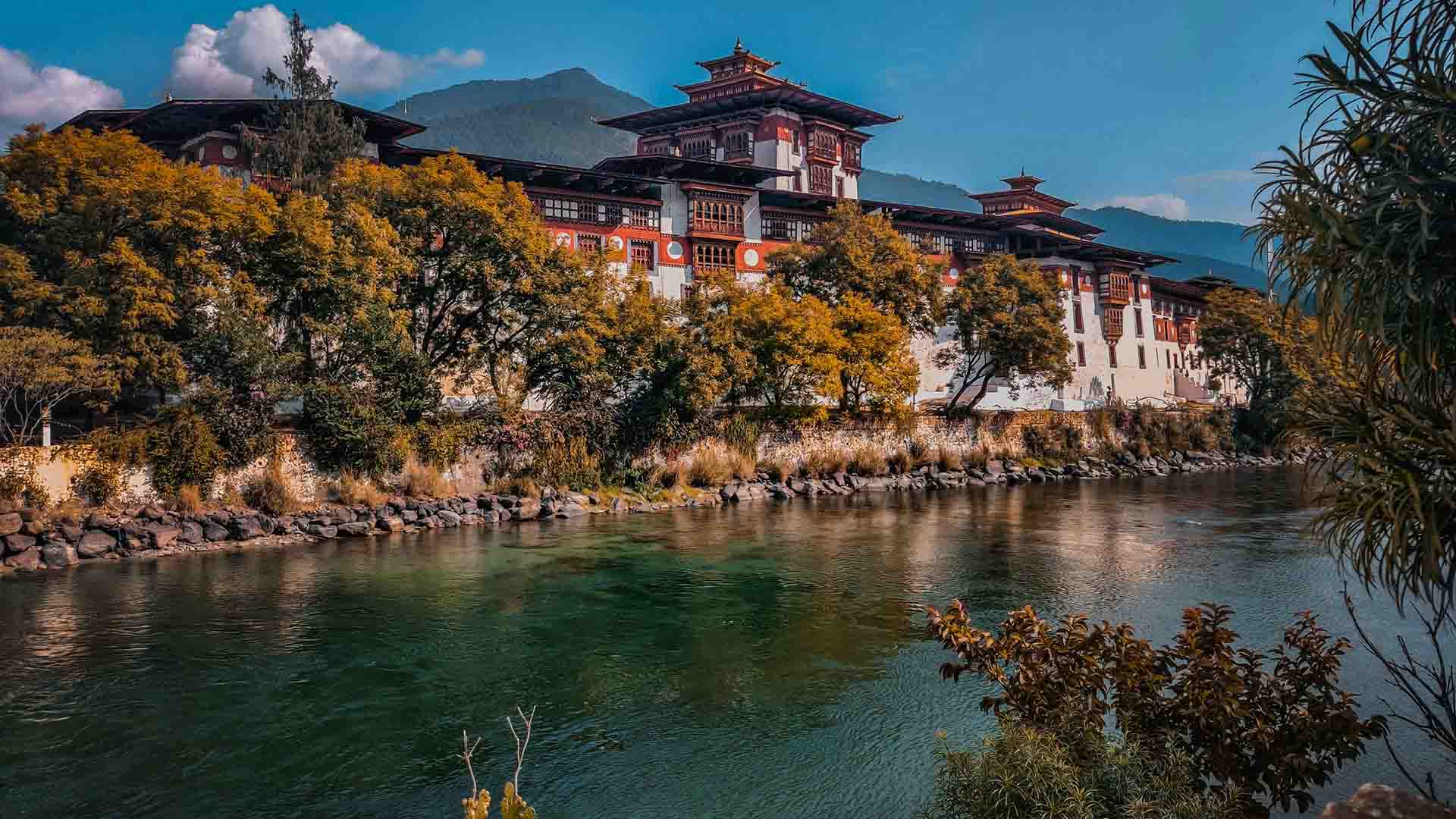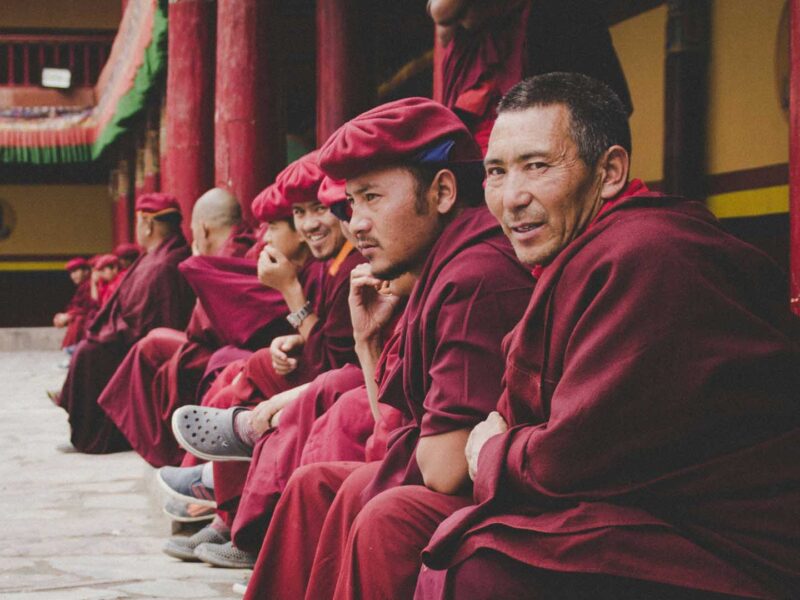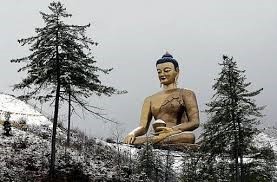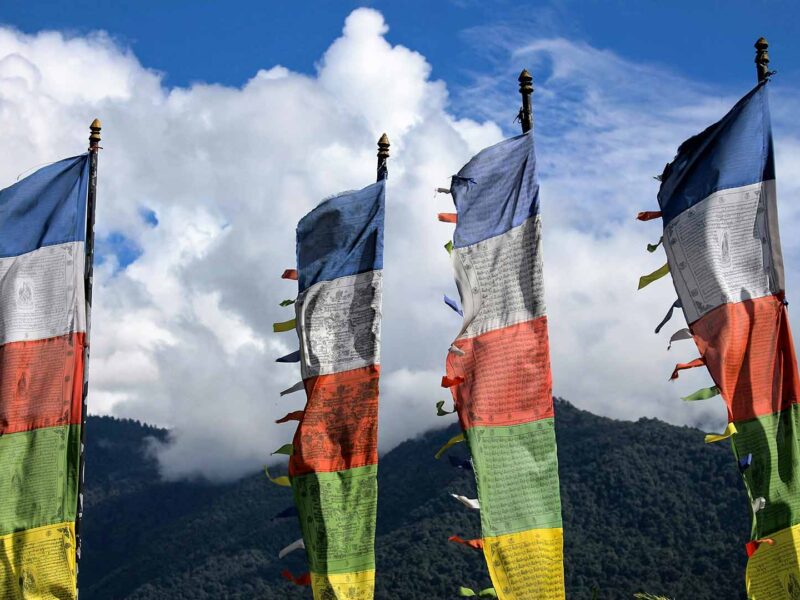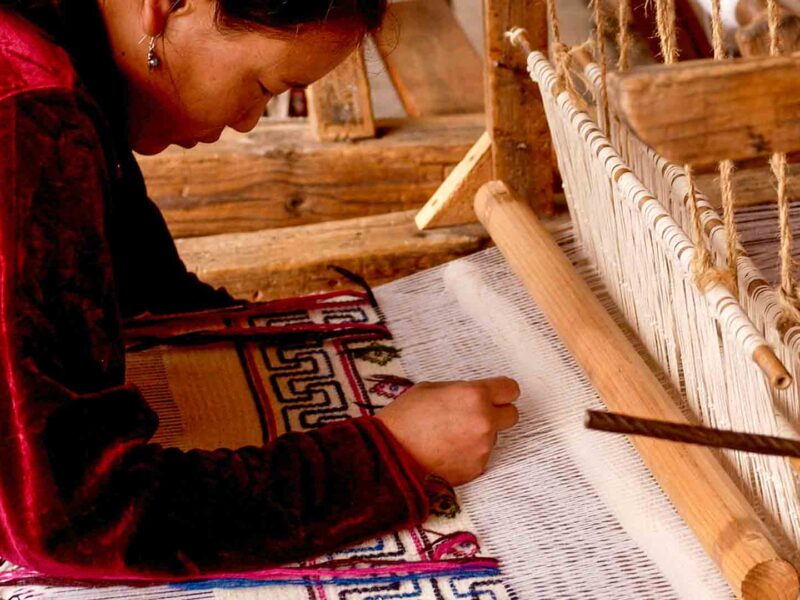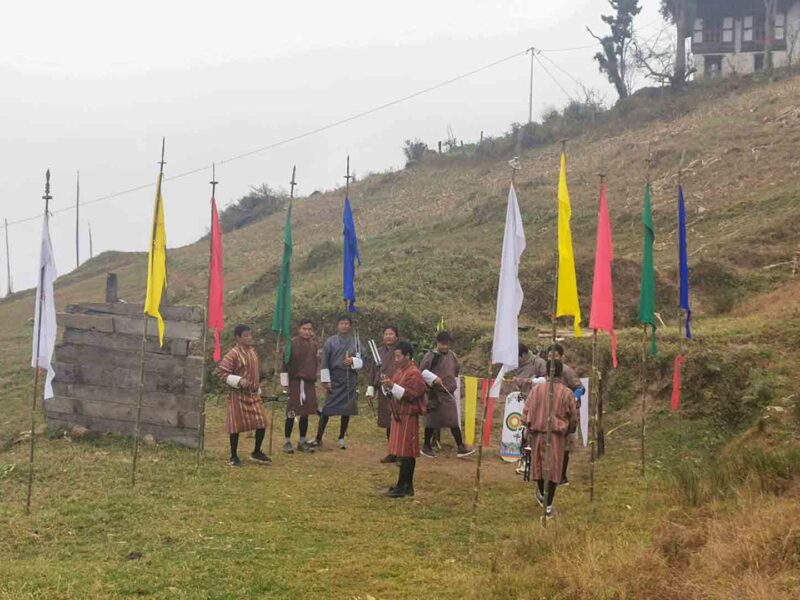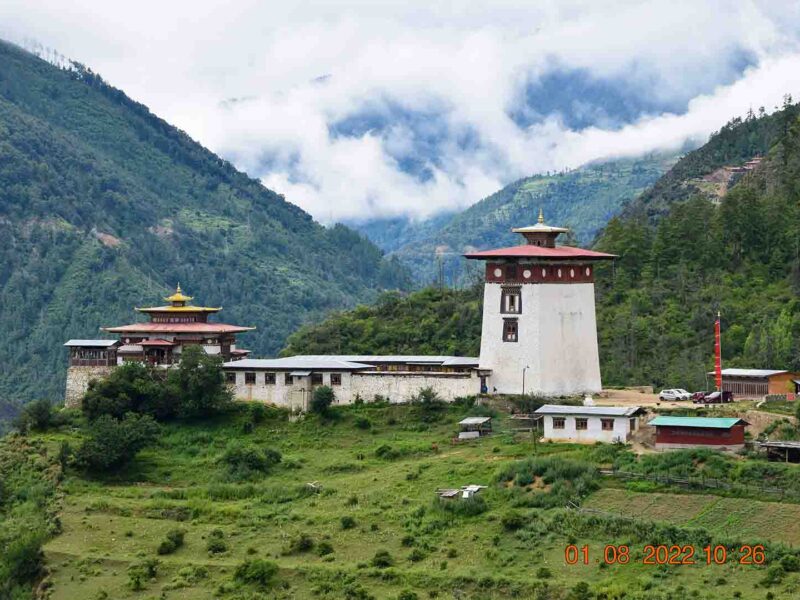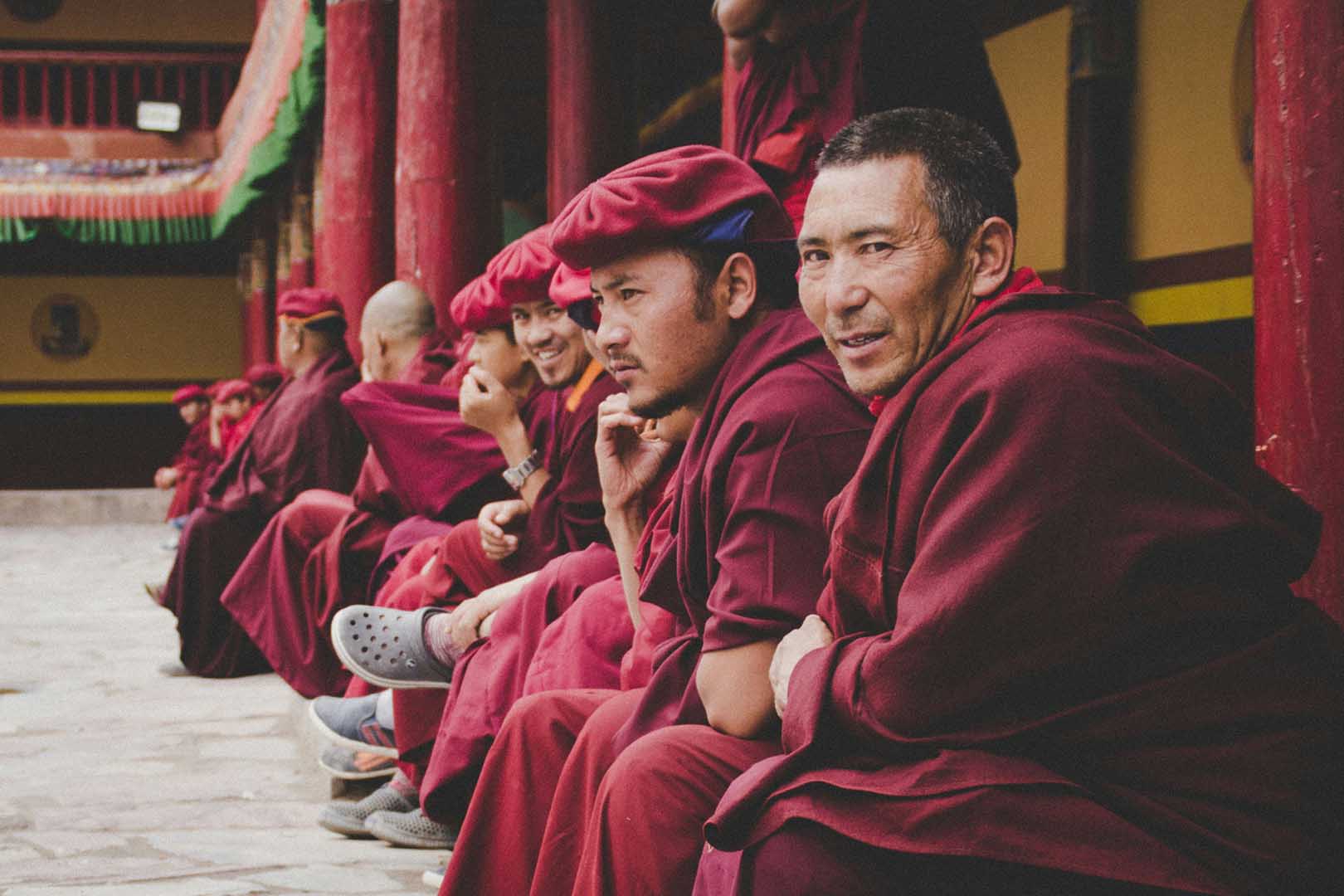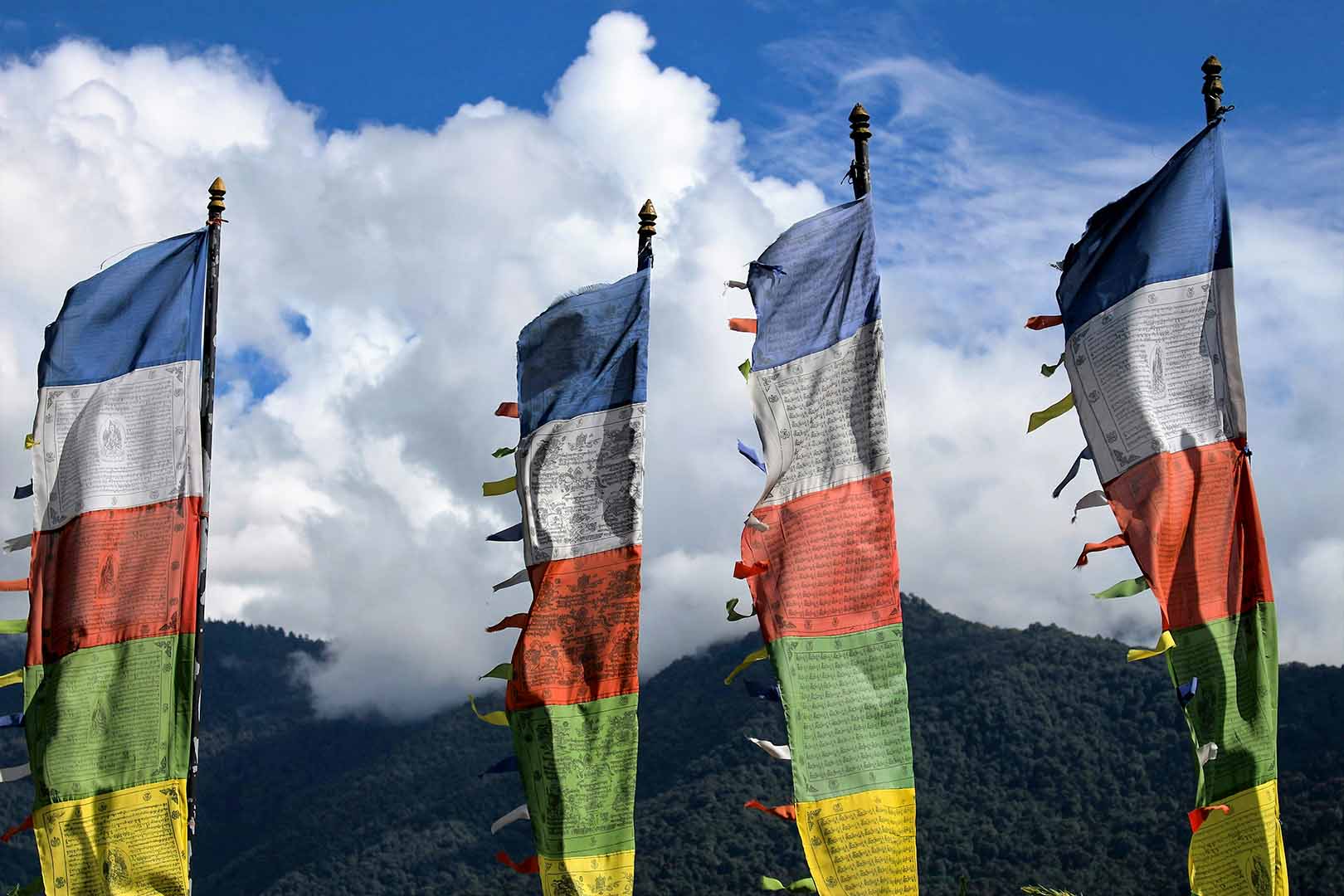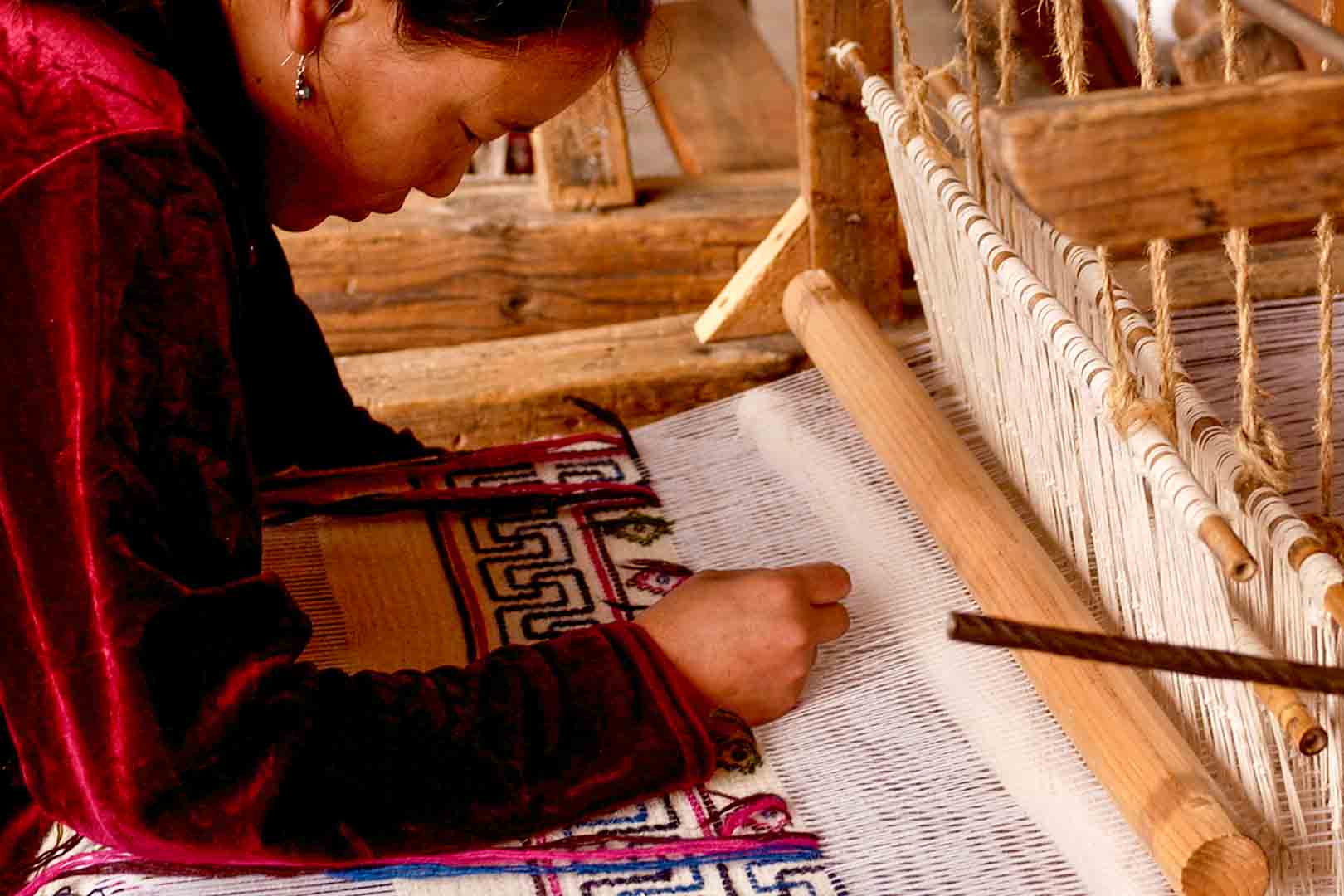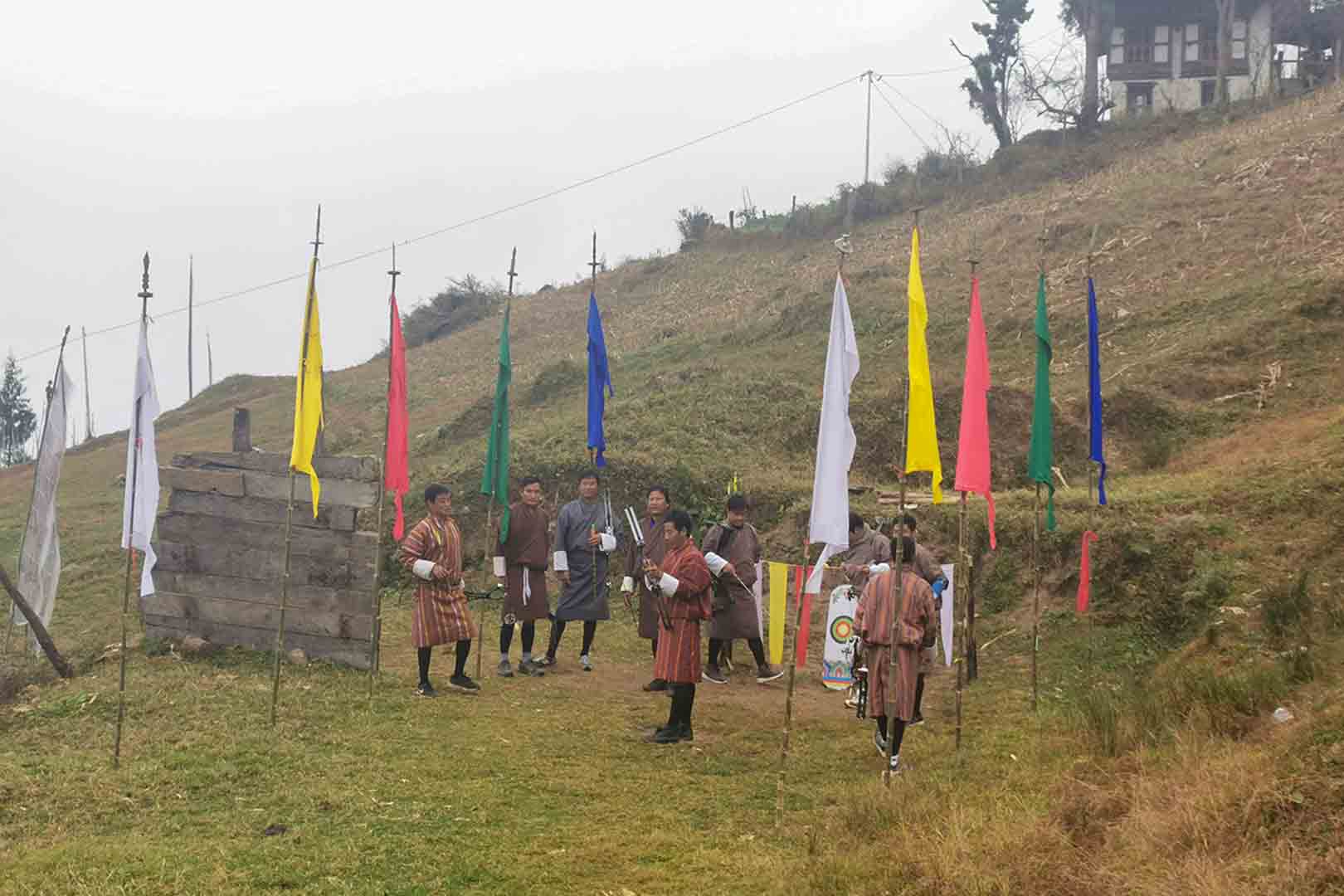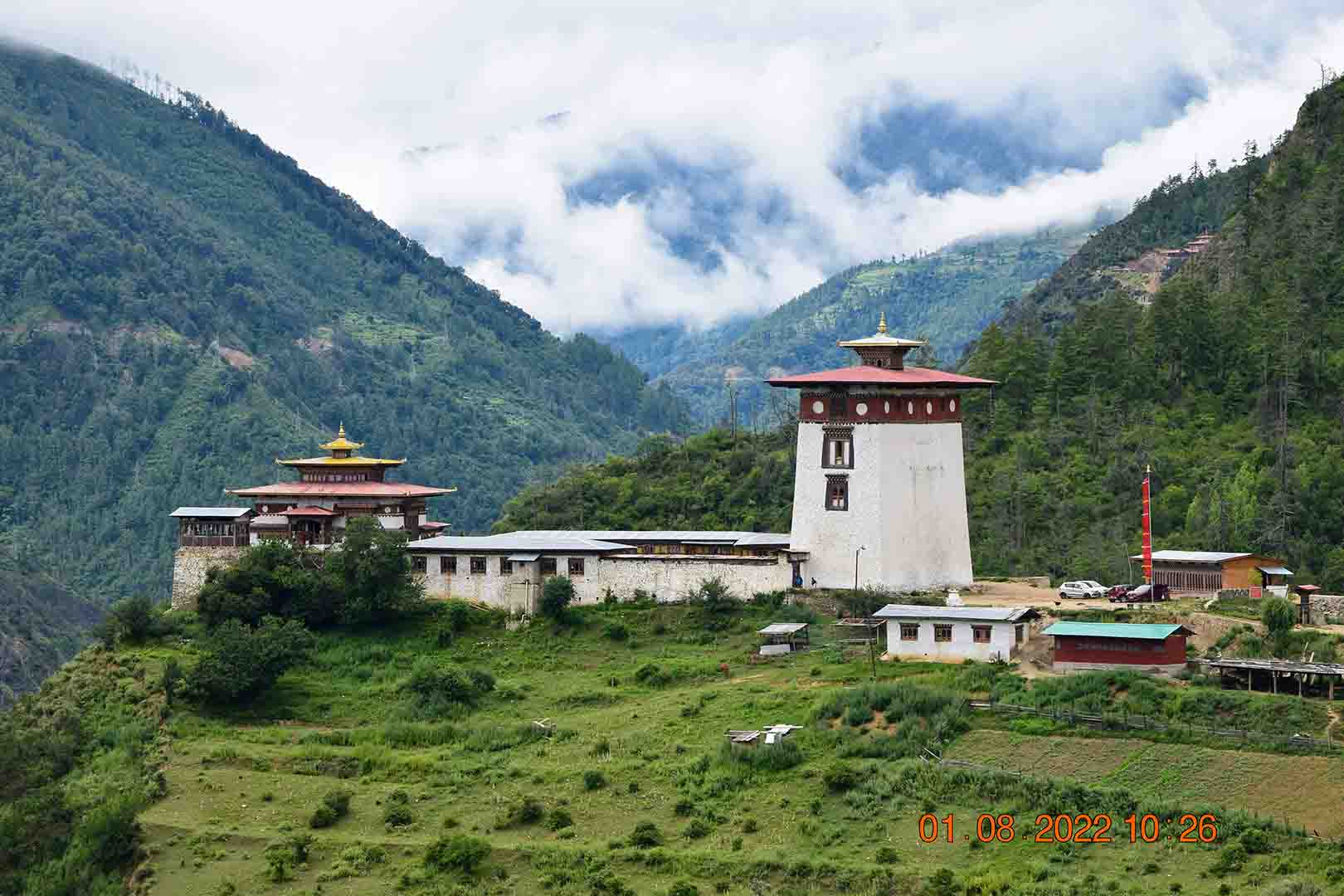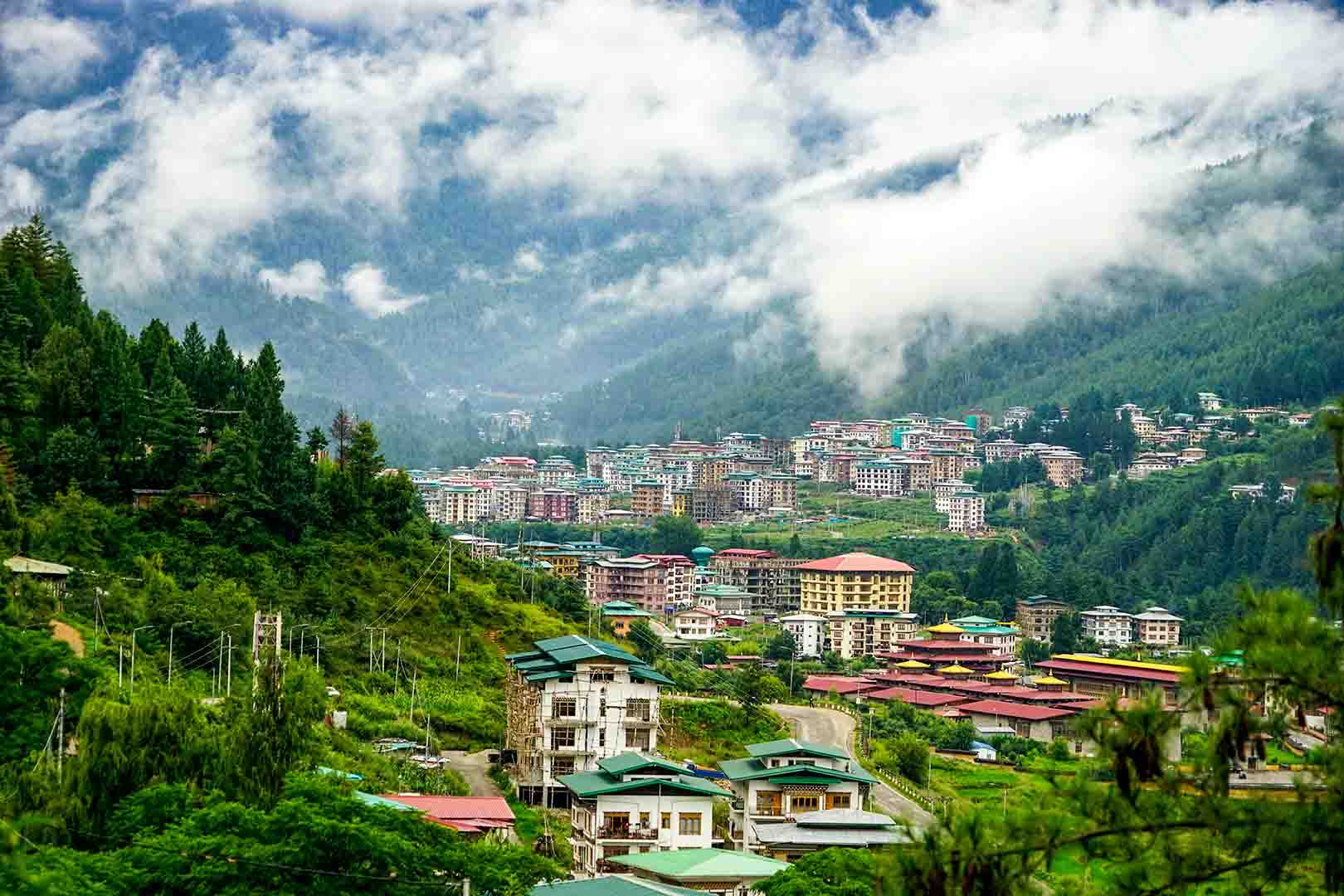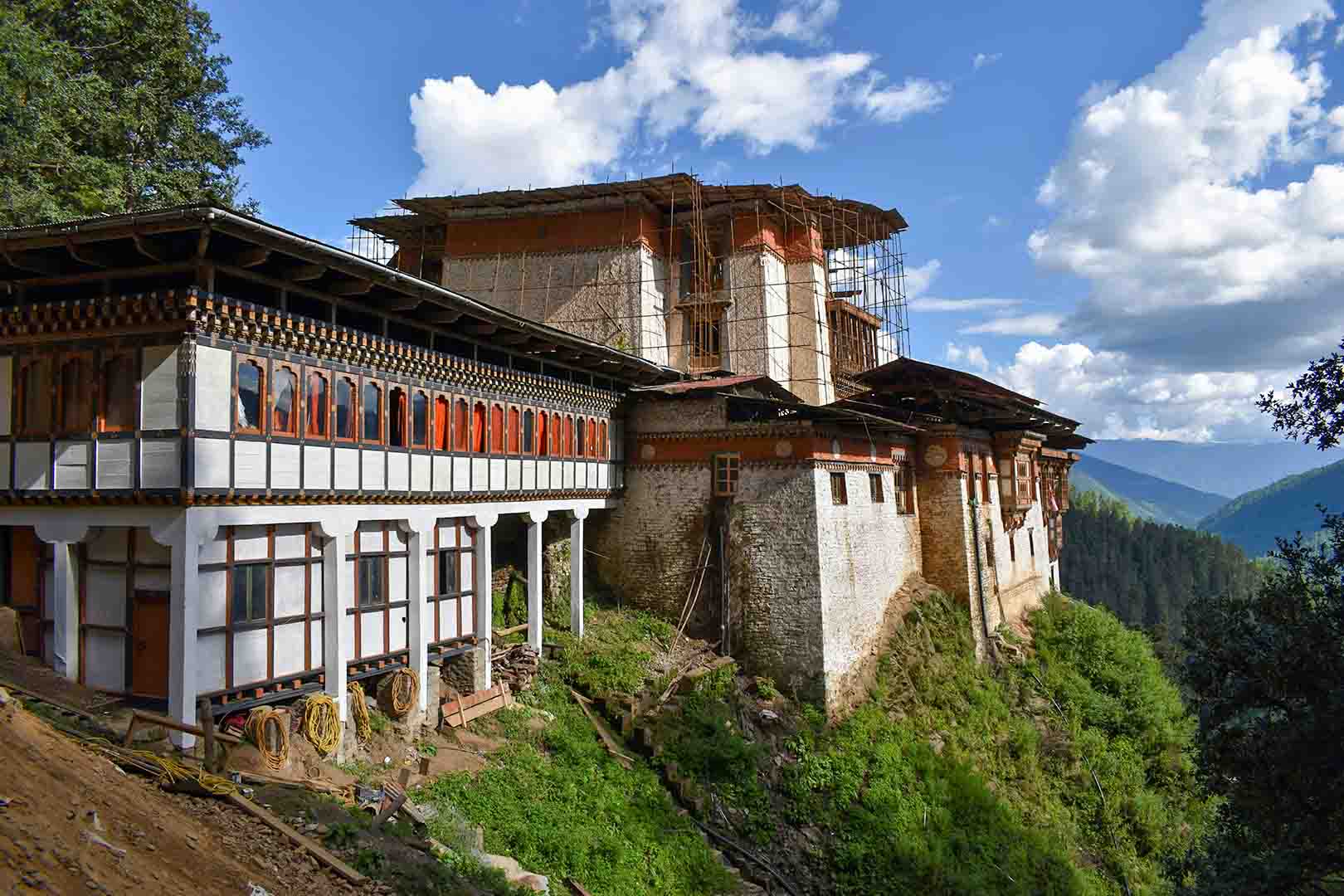Day 01: Thimphu (L/D)
Fly into Paro by Druk Air.
Please present a copy of the Druk Air tickets at the counter of the Druk Air in Bangkok at the time of check-in. All tickets have return portion of the journey as well and should be kept with you in safe place.
Please remember to arrive at least 2 hours prior to your flight. It is better to reconfirm your flight timings with Druk Air as they could change.
A flight into Bhutan is spectacular with views of Himalayas. Upon arrival in Paro, clear customs and immigration. Keep your copy of the visa clearance letter handy. P.P size pictures are no longer required and your visa has been paid. Meet your Guide and driver outside the terminal building and transfer to Thimphu. In Thimphu visit Memorial Chorten and Tashichho Dzong. Stroll around the city in the evening. Welcome dinner and overnight Thimphu.
Drive from Paro to Thimphu: The distance of about 65kms from Paro town takes little less then 2 hours. Drive south following Pachu river to the river confluence at Chuzom, which is also the hub of road network going to Paro, Ha, Thimphu and Phuntsholing. From Chuzom, the drive takes about 1 hour, staying close to the Wangchu River in the valley floor, as you pass through villages and suburbs to the capital, Thimphu. En-route, you can stop to view Tachogang temple and the nunnery at Sitsina.
Memorial Chorten: This landmark of Thimphu was built in 1974 in the memory of third King, Jigme Dorji Wangchuk, who is popularly regarded as Father of Modern Bhutan. It is a four-storey tall white building, containing statues and iconography of deities from complex tantric teachings and serves as an important place of worship for Thimphu residents, as well as from other parts of the country.
Tashichhodzong: This fortress serves as the office of the King, ministers and various government organizations. It also is the headquarters for central monastic body of Bhutan. Bhutan's spiritual leader Je-Khenpo and the monks of both Thimphu and Punakha reside here during summer. It is also the venue for Thimphu Festival (Tsechu) in the fall season.
Thimphu (2,300m): was a wooded farming valley until 1961, when it became Bhutan's official national capital. The massive Tashicho Dzong, about 700 years old, was carefully revamped in the 1960s by the late King Jigme Dorji Wangchuk to house the royal and main government offices. Even today, it still only has a few streets and no traffic lights with estimated population of 125,000 people.
Day 02: Thimphu (B/L/D)
Full day sightseeing in Thimphu.
Visit Takin Sanctuary, Zilukha Nunnery, Indigenous Hospital, Textile Museum, Heritage Museum, Traditional School of arts & crafts and on available time, you will also visit Zangdopelri temple, paper factory and other sights. Overnight Thimphu.
Takin Sanctuary: Takin (Budorcas taxicolor) has been chosen as the national animal of Bhutan is based both on its uniqueness and its association with country’s history and mythology. It is said that Devine Madman, a popular saint is said to have created it with his magical power at a large congregation of devotees. It resembles like a cow from back and goat in the front and continues to befuddle taxonomists, who cannot quite relate to other animal.
Zilukha Nunnery: It has been housed in Drubthob Goemba (monastery). There are about 70 nuns who live and pray everyday in the monastery. The beautiful view of Tashicho Dzong can be seen from the nunnery.
Indigenous Hospital or National Institute of Traditional Medicine (Open 9-5pm Mon-Fri, 9-1pm on Sat) is government funded institute that facilitates research of traditional medicine and practices. It prepares and dispenses herbal and other medicines with clinic where doctors diagnose and prescribe traditional medicines or treatments.
School of arts & Crafts (open 9-5pm mon-fri and 9-1pm on Sat –with exceptions of holidays and breaks). Commonly known as ‘the painting school’ is a national institute where children attend six-year course that provides instruction in Bhutan’s traditional arts and crafts called Zorig Chuksum - meaning 13 crafts.
Heritage Museum: Heritage Museum is also a recent addition; housed in a traditional home displays the living style of the Bhutanese family in 19th century.
Textile Museum: A recent addition in the capital city, this museum displays the colorful and intricately hand woven textile, both old and new.
Paper Factory: Traditional papers were made from the daphne plant, using simple methods.
Day 03: Gangtey (Phobjikha) (B/L/D)
After breakfast, drive to Gangtey. Enroute stop at Dochula and brief stop at Wangdiphodrang town. Visit Gangtey Monastery and take walk in the valley. Overnight Gangtey.
Drive from Thimphu to Gangtey: Drive to Gangtey (Phobjikha) takes about 5 hours covering distance of 138 km. The road climbs from Thimphu to Dochula pass (3,050m) and descends through ever changing forests into the semi-tropical valley of Punakha and Wangdi at around 1200m.
En-route stop at Dochula pass (3050m) where you can view the eastern Himalayas, including Bhutan's highest mountain, Gangkar Punsum (7,550m).
From Wandue, drive uphill almost crosses over Pele La pass 3400m. Before, reaching the pass, the road diverges and we take the road least traveled by. This eventually leads into the 'hidden valley' containing the stunningly beautiful monastery of Gangtey Gompa.
Phobjikha Valley: Phobjikha (3000m) is a wide-glacial and beautiful valley, designated as conservation zone within the Black Mountains National Park, a natural habitat for wildlife, including nesting black-necked cranes from Central Asia (mid autumn till early spring). Because of the conservation measures, there is no electricity in the valley. The lodges use solar powered cells or generator to light which is turned of after dinner. Hot water is provided in the bucket and rooms are heated with wood stoves.
Gangtey Gompa: Gantey Gompa monastery sits atop a hillock that overlooks the Phobjikha valley. It is headed by the ninth Gangtey Trulku and is the largest Nyingma monastery in western Bhutan. It was founded in 1613 by Gyalse Pema Thinlay, a grandson and reincarnation of influential treasure finder Pema Lingpa. Incarnate line of Pema Thinlay, representing the body aspects of Pema Lingpa, contrasted with mind and speech emanations. The monastery has been recently built and surrounding the monastery are village homes and hermitages.
Black-necked Crane: ‘Thrung Trung Karmo’ as this bird is passionately called in Bhutan is subject of many Bhutanese songs and folklore. They are seen among the painting on the walls of temples and Thankga. These endangered species of cranes migrate from Tibet in late autumn and typically stay till the mid march. About 3-400 cranes reside in the wetland in the center of the valley. The Observation & Education Centre (open 7-7pm – Mon-Fri) has informative display about the cranes and conservation effort in the valley.
Day 04: Jakar (B/L/D)
Drive to Jakar (Bumthang). Stop at Chendebji and Trongsa. Lunch at Trongsa and drive to Jakar. Stop at Zugney to see the Yathra Weavers. Overnight Jakar.
Drive from Gangtey to Jakar: The drive to Jakar (Bumthang) takes about 5-6 hours covering distance of approx. 160 km. The road climbs again to Pele La pass (3400m) where we make stop for views of the snow clad peaks, including that of Bhutan’s sacred peak Mt. Chomolhari. After crossing Pelela pass, descend and pass through the villages of Rukubji, Chendebji, Sephu, Langtel and several other villages and arrive in Trongsa for lunch.
From Trongsa, the drive to Jakar takes about 2 ½ hrs. Climb from Trongsa to Yotong La (3,551m) and descend into Chumey valley (2,700m), the first of four Bumthang valleys. Then it is another 45 minutes, past the villages of Zugney and Prakar, and across Kiki la pass (2,860m) to arrive at Jakar, the administrative center of Bumthang district.
Yathra Weaving at Zungney: Yathra is colourful wool weaving pattern native of central Bhutan with deep colors. In the village of Zugney in Chumey valley, there are shops, where you can see the weavers- at-work. You may be able to see the dyeing of wool using natural dyes and other processes.
Bumthang is justifiably regarded as the cultural heartland of the kingdom with its many temples, holy sites, languages and traditions. It is here that most kings, rulers or priest were buried or cremated. There are four valleys and Jakar at 2,800m in Chokhor valley is the administrative center and the main town of Bumthang district.
Day 05: Jakar (B/L/D)
Bumthang Sightseeing.
Visit Jambay temple, Chamkhar Lhakhang, Kurje temple, Tamshing Monastery, Kenchosum temple, Jakar Dzong, Swiss Farm, Wangdicholing and upon available time visit the Hospital, local village, wood craft center and other sites. Overnight in Jakar.
Jambay Lhakhang: is another one of the geomantic temples (like Kichu in Paro) founded in 7th century by a Tibetan King Songtsen Gompo, this time on the ‘left knee of the ogrees’. Guru Rinpoche is said to have taught the local king Sindhu Raja from the temple roof in the 8th century.
Chamkhar or Chakar Lhakhang, was originally a nine-storey ‘iron castle’ palace of 8th century King Sidhu Raja, which was replaced by more modest building in 4th century. The present building was constructed in early 20th century. It also houses the ritual dance masks used at the Jampay Lhakhang festival in the late autumn.
Kurjey Lhakhang: Kurjey is named after the sacred power place where Guru Rinpoche (8th century) left the imprint of his body on the solid rocks, which can be seen from inside the shrine. There are three large temples within the complex surrounded by a perimeter comprising of 108 stupas. Upon entering, the first temple to the right is Guru Lhakhang (which houses the cave) dating from 1652. The middle temple Sampalundrup was built by the first King Ugyen Wangchuk in 1900, during his tenure as Trongsa Penlop. The third temple is recently constructed under patronage of Her Majesty queen mother Ashi Kesang Wangchuk.
Tamshing Temple: Located opposite Kurjey Lhakhang this temple was founded by Bhutan's own religious treasure discoverer, Terton Pema Lingpa in 1501. Believed to be the reincarnation of Guru Rinpochey, he discovered many religious treasures around the country. The original murals on the walls still survive, which are considered to be the oldest extant painting in Bhutan.
Kenchogsum Temple: Ten minutes walk south from Tamshing is a small temple of Konchogsum. The temple was restored in 1995 and looks new, but it actually dates back to 7th century. This temple has many interesting stories to tell.
Jakar Dzong: “Jakar Dzong” literally meaning castle of the white bird is in a picturesque location overlooking the Chokhor valley. The current structure was built in 1667 and later refurbished in 1683, is said to be one of the largest dzong in Bhutan, with impressive fortress walls, elegant structure but rather simple interior.
Wangdichholing Palace The extensive palace of Wangdichholing was built in 1857 on the site of the battle camp of the Governor of Trongsa, Jigme Namgyel, father of the first King Ugyen Wangchuk (who was later born here). It was the first palace in Bhutan that was not designed as a fortress. Both the first and second king used adopted Wangdicholing as their main summer residence. There are five large water driven prayer wheels inside square stupas as you approach the gates of the palace. Although you may get inside, it is interesting to see from outside.
Swiss Farm Area: There is a small factory on the other side of the river which produces Swiss Cheese, Bumthang honey and apple wine and local beer called ‘Red Panda’. It is an interesting place to visit and taste some local made products, started by a Swiss Bhutanese.
Day 06: Bumthang (B/L/D)
Excursion to Ura valley to explore Ura village. Drive to Ura and back to Bumthang along the same road. The round trip takes about 3 hours. Enroute visit Membertso (burning lake). Overnight Jakar.
Drive from Bumthang to Ura: Ura is 48 km away from Bumthang and takes one hour thirty minutes. It passes via Membartso and croses over a pass. The name of the pass is Shertangla (3590 m). Just before reaching the pass, the view of Gangkhar Phuensum – highest mountain of Bhutan (7514 m) can be seen. From the pass, the road descends down to Ura valley.
Membertsho (Burning Lake):
It falls along Bumthang – Ura Road. It is about 20 minutes drive from the hotel where you stay and then about 10 minutes of walk. The significant of this place is that Pema Lingpa in the early 16th century discovered many religious items from a pond here.
Ura Village:
Located in a broad valley (3100 m), Ura village is a clustered of traditional houses fenced by cobblestone streets that give the village a mediaeval atmosphere. The people of this region are primarily sheep and yak herders. You will see the traditions that have been alive for thousands of years. There are about 50 houses closely packed. The women in Ura village cover their head with white cloth piece to protect from the harsh cold wind and carries sheepskin (behind their back) used as cushion and as well as to protect their cloth from the loads they carry. There is a temple at the center that dominates the village.
Day 07: Trongsa (B/L/D)
Drive to Trongsa. Visit Trongsa Dzong and Watch Tower. If you have not covered Zungey Yathra weavers previously, you will be able to see it today. Overnight Trongsa.
Drive from Bumthang to Trongsa: The drive to Trongsa, 68km and takes about 2-3 hours. Retrace the drive across Kiki la into Chume valley, and cross Youtongla pass (3,551m) into Trongsa.
Trongsa Dzong: or Choekhor Rabdentse is the largest and most impressively situated dzong in Bhutan, perched high on a cliff above the deep Mangdechu river gorge. It was built in 1648 on the site of temple which was built in 1543. The huge many-level fortress with its intricate wood carvings has a maze of courtyards and covered passages that follow the contour of the ridge. First and second King ruled the country from this fort and all successive Kings have held the post of Trongsa Penlop, (honorary governor) prior to being crowned as the King.
Ta Dzong: The watchtower above the town area is shaped like tower with wings. It contains a shrine dedicated to Gesar, the legendary epic warrior king, and another named after Jigme Namgyal, the father of the first king. The views from the tower of the dzong and town is spectacular and in ancient times, all approaches could be monitored from here.
Trongsa: Trongsa (2,200m) lies at the geographical center of Bhutan. The town of Trongsa has been developing since 1980’s, with many of the shops being owned by Bhutanese of Tibetan decent. This small town located is on the face of the ridge and at the cross-road junction of lateral east-west highway, and the road leading south to Shemgang.
Day 08: Punakha (B/L/D)
Drive to Punakha. In the evening visit Chimi Lhakhang in Punakha. Overnight Punakha.
Drive from Bumthang to Punakha: The drive to Punakha from Jakar, 200 km and takes about 6-7 hours. Retrace the drive across Kiki la into Chume valley, and cross Youtongla pass (3,551m) into Trongsa. Leaving Trongsa, the road winds for 14kms north west via Tsamkhar to cross Mangde chu river at Bjizam. After driving for nearly one hour, you can still see the Trongsa Dzong, so close enough that you feel as though you can touch. Retrace through the villages of Tangsibji, the chorten at Chendebji, and then though villages of Sephu Nikachu, Rukubji and climbing up the nomadic settlements, and Yak country to Pele la pass (3,420m). From the pass descend through the changing vegetations to semi tropical Wangdiphodrang town and 20 minutes away from Wangdue along the same lateral highway is Punakha.
Chimi Lhakhang: a monastery and fertility temple dedicated to Lama Drukpa Kuenley, a Tibetan Buddhist saint known popularly as “the divine madman” and considered a folk hero in Bhutan for his unconventional ways. Drukpa Kuenley originally built a chorten on the site in the 14th century, on which a temple was later built in 15th century. The temple, flanked by nearly 100 tall prayer flags, sits atop a picturesque hill. It has long been a pilgrimage site for childless couples. This easy walk takes about ½ hour each way.
Punakha and Wangdiphodrang: Punakha and Wangdue, although two separate districts, are located in one valley (20km/ ½ hr drive apart) and they are at the lower elevation of about 1,250m with pleasant winters. Cactuses, Oranges, bananas and sub-tropical plants are found here. Punakha was once the winter capital of Bhutan, the tradition that is still held by the Central Monastic body.
Day 09: Punakha & Wangdiphodrang (B/L/D)
In the morning, visit Punakha Dzong and then drive to Wangdiphodrang 20km away from Punakha to attend the Wangdue Tsechu (festival) held inside Wangdiphodrang Dzong. Overnight Punakha.
Punakha Dzong: or Pungthang Dechen Phodrang "Palace of Great Happiness" is located on the confluence of two rivers, the Pho and Mochu. It was built in 1637 by Shubdrung Nawang Namgyal and following the ancient traditions, it serves as winter residence for chief abbot (Je-khenpo) and the monks of Central Monastic Body, who return to Thimphu in the summer.
Wangdiphodrang Dzong: Shubdrung Nawang Namgyal in 1638 had built this massive fortress sitting on a hilltop at the confluence of Punakha Chu and Tang Chu Rivers. It is built in the shape of a sleeping bull. Wangdi festival is celebrated here in the autumn.
Wangdue Tsechu: Religious festivals are numerous and have different names according to their types, the best known being the ‘Tsechus’, which are festivals in honour of Guru Rimpoche, commemorating one of his great deeds. These great deeds are all believed to have taken place on the 10th day of the month, which is the meaning of the word ‘tsechu’.
Tsechus are celebrated for several days, between three and five according to the location, and are the occasion for dances that are clearly defined in religious content. The dances are performed by monks, laymen or gomchens and the repertory is the same practically everywhere. For the Bhutanese, religious festivals offer an opportunity to become immersed in the meaning of their religion and to gain merit. They are also occasions for seeing people, and for being seen; for social exchanges, and for flaunting success. People bring out their finest clothes, their most beautiful jewels; they take out picnics rich with meat and abundant alcohol. Men and women joke and flirt. An atmosphere of convivial, slightly ribald good humour prevails.
Day 10: Thimphu (B/L/D)
Drive across Dochula pass to Thimphu. Attend Thimphu Tsechu (Festival), the largest in the country. Overnight Thimphu.
Drive from Punakha to Thimphu: The drive from Punakha to Thimphu takes about 2-3 hours, covering total of 75 km. From Punakha, climb back to the Dochula pass (3,050m), where you have another opportunity to view the peaks of the eastern Himalayas. Descend to Thimphu from Dochula takes about 40 minutes.
Thimphu Tsechu: Religious festivals are numerous and have different names according to their types, the best known being the ‘Tsechus’, which are festivals in honour of Guru Rimpoche, commemorating one of his great deeds. These great deeds are all believed to have taken place on the 10th day of the month, which is the meaning of the word ‘tsechu’.
Tsechus are celebrated for several days, between three and five according to the location, and are the occasion for dances that are clearly defined in religious content. The dances are performed by monks, laymen or gomchens and the repertory is the same practically everywhere. For the Bhutanese, religious festivals offer an opportunity to become immersed in the meaning of their religion and to gain merit. They are also occasions for seeing people, and for being seen; for social exchanges, and for flaunting success. People bring out their finest clothes, their most beautiful jewels; they take out picnics rich with meat and abundant alcohol. Men and women joke and flirt. An atmosphere of convivial, slightly ribald good humour prevails. The details and the meaning of the each dance performed will be explained to you by your guide. After festival, you may drive back to the town and visit few shops and handicraft stores and interact with the locals.
Day 11: Thimphu (B/L/D)
Attend Thimphu Tsechu (festival) and visit Weekend Market. There will be time in the afternoon for self guided tour of the capital city. Overnight Thimphu.
Weekend Market: The colorful weekend market of Thimphu is held from Friday-Sunday. Residents of Thimphu and country sides come to shop for food and clothes. There are some handicrafts and gifts shop as well, and provide a great photography scene.
Day 12: Paro via Haa (B/L/D)
After breakfast, drive to Ha via along the Ha Chhu road (3-4 hrs ). Walk in Haa valley and drive to Paro across Chelila pass and visit Kila Gompa Nunnery enroute. Overnight Paro.
Drive from Thimphu to Haa:
After breakfast, proceed to Haa valley, which takes about 4 hours. Drive south and then west on a scenic route. Driving and birding through a wonderland of vast forests occasionally interspersed with farmlands that never fail to delight the eye.
Haa Valley:
Haa valley at 2670 m was recently opened to tourists and is situated in the temperate region among the Blue pine forest. Explore valley and walk around villages visiting farm houses and village homes.
Hike to Kila Gompa Nunnery:
If you wish to break your journey, you may hike from a short descend from the Chelila pass to Kila Gompa Nunnery It is about a half hour uphill and shorter coming down hill. The hike brings you to a clusters of shelters built on sheer cliffs, under the rock/cave and a temple that houses some 50 or so nuns. Walk back to the point to meet the transport.
Drive from Haa to Paro:
This morning a scenic drive of 1 hr will bring us to Chele La pass at an altitude of aprrox. 3900m/1300ft. On one side is the Paro and on the other side is Haa valley. It is another 1 hour drive down hill to Paro Valley from the Chelila pass.
Paro: Paro is one of the most beautiful valleys in the country with Bhutan’s only airport located here, among the terraced fields, and elegant farm houses. Willow trees line many of the roads, contrasting with bright colors of the fields and the most popular and important sites also found within Paro district. Paro town (2,280m) is still a small with one main street and less then one hundred small family-run shops. The weekend market in Paro is held on Saturdays.
Day 13: Paro (B/L/D)
Hike to Tiger’s Nest Monastery and visit local farm house. Free time in the evening to stroll around the town. Overnight Paro.
Hike to Taktsang: Drive to north of Paro town for about ½ hr and embark on a trek to the famed Taktsang (Tiger’s lair) monastery. Taktsang monastery is located on the face of a 1,000m seemingly impossible sheer, vertical cliff, above Paro valley.
The trail begins near the Satsam (2650m) and climbs steeply uphill to the Cafeteria (2,940m), an area of exposed ridge with panoramic view of Takstang. This takes little more then an hour. (Ponies are provided on request to ride up till this Cafeteria, but rest of way, including return downhill must be on foot.) You can get a good view from the Cafeteria or hike further uphill for another hour or so to the temple itself. There are several other temples and sites within the vicinity. Lunch is served at the tea house. The return trek to the road head is quite steep downhill, where you will be met by the transport.
Typical Farm House: Bhutanese farmhouses are colorful, decorative and traditionally built without any nails. Majority of the houses are with three story, first floor is utilized for sheltering cattle, second floor for the family to live in and the top for storing and drying of foods and fodder for animal. Almost all the farmhouses follow the same architectural pattern. A visit to farmhouse is interesting and provides you with an experience to the daily life of average Bhutanese.
Day 14: Paro (B/L/D)
Paro sightseeing full day; visit National Museum, Rinpung Dzong, Kyichu temple complex, Dungtse temple and ruins of Drukgyel Dzong and other sites as per time available. Overnight Paro.
National Museum: Established in 1967, the museum is housed inside a circular Ta Dzong, an ancient Watch Tower. It holds fascinating collection of arts, relics, religious thangkha paintings, households stuffs, arms, handicrafts, stuffed animals and Bhutan’s famous Stamps among others. (open 10-4pm – closed on Monday).
Rinpung Dzong: meaning "fortress of the heap of jewels". Built in mid 17th century, it now serves as the administrative and judicial seat of Paro district and residence for the 200 monks of Paro. It is also the venue for Paro festival held in the spring. Several years ago, the colourful movie Little Buddha was filmed here.
Kyichu Lhakhang: Tibetan King Songtsen Gompo in the 7th century miraculously built 108 temples, along with Jorkhang in Lhasa. Kyichu is considered to be one of them and is one of the oldest temples in Bhutan.
Dungtse Lhakhang: was constructed by the great bridge-builder Thangtong Gyelpo in 1433. It is said to have been built on the head of demoness, who was causing illness to the inhabitants. The building was restored in 1841 and is a unique repository of Kagyu lineage. You may or may not be permitted inside but can walk around this three-storey Chorten type building.
Ruins of Drukgyel Dzong: Ruins of Drukgyel dzong stands 14 km north of Paro town at the end of the road. It was built in 1644 to commemorate the victory f Bhutan over Tibet. It served as the administrative and religious center for Paro until 1951 when fire broke out and damaged this huge structure. Now it stands in complete ruin
Day 15: Paro (B)
After breakfast, transfer to the airport in time for your departure flight to onward destination.
Tashi Delek !

